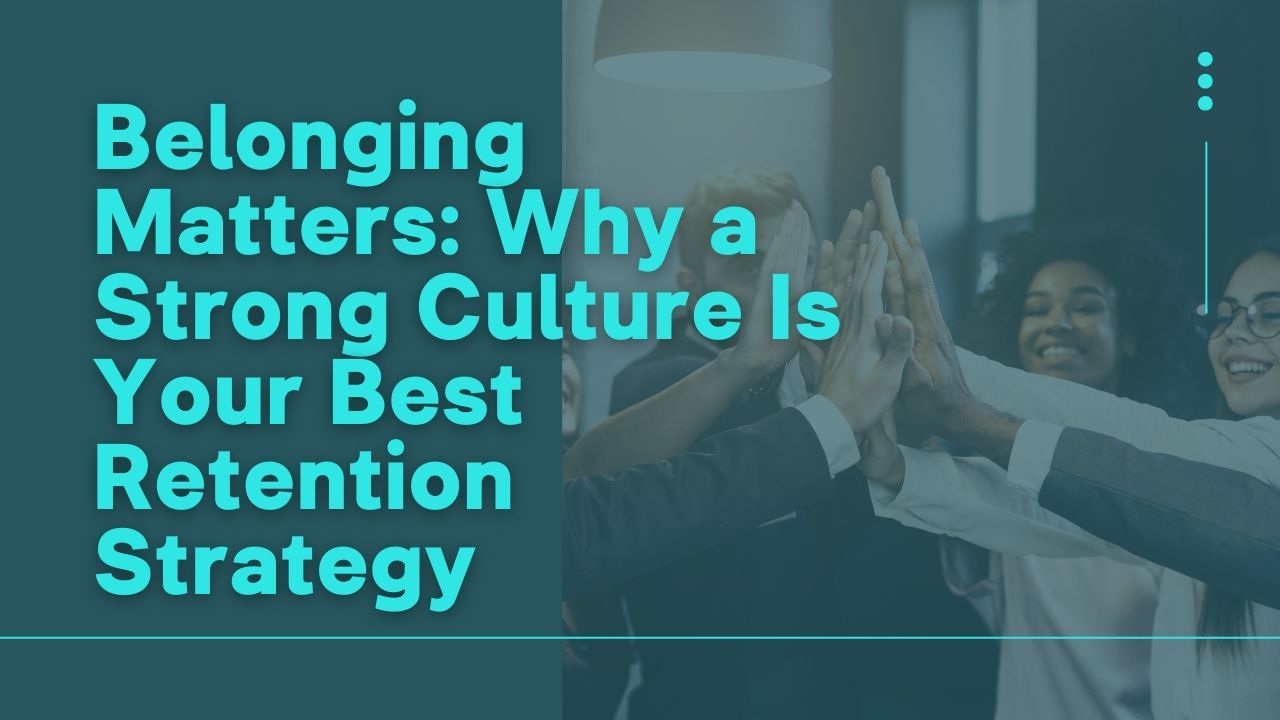Belonging Matters: Why a Strong Culture Is Your Best Retention Strategy
Mar 01, 2025
In a meeting room somewhere right now, an executive team is reviewing their quarterly turnover numbers and wondering why their latest round of retention bonuses didn't move the needle. Meanwhile, down the hall, another talented employee is drafting a resignation letter—not because of money, but because something less tangible is missing.
We've been thinking about employee retention all wrong.
The Missed Connection in Retention Strategies
For decades, companies have approached retention as primarily a compensation problem. When valued employees consider leaving, the playbook is predictable: counter with a raise, add perks or perhaps throw in a new title. Yet turnover persists, particularly among the most talented contributors.
The standard explanations—"better opportunities," "lack of growth," or "misalignment with values"—only scratch the surface of a deeper human reality: People don't leave jobs; they leave communities where they don't feel they belong.
Companies like Netflix, Salesforce, and Patagonia don't just have retention strategies—they've built cultural ecosystems where belonging makes departure almost unthinkable.
Workplaces as Sub-Cultures
Anthropologists have long studied how human communities form, sustain themselves, and occasionally dissolve. When we apply this lens to workplaces, something remarkable becomes clear: organizations function as sub-cultures with their own:
- Rituals: The practices that reinforce shared identity.
- Value systems: The principles that guide decision-making.
- Social contracts: The unwritten rules governing relationships.
- Narrative traditions: The stories that explain "how we do things here".
The companies with the strongest retention understand this intuitively. They're not just building profitable businesses—they're cultivating communities where employees experience work as part of their social identity.
The Anatomy of a Culture People Don't Want to Leave
1. From Transactions to Cultural Connections
Traditional employment follows a market exchange model: labor for compensation. This transactional view creates psychological distance between employees and organizations, making departure a relatively simple calculation of better terms elsewhere.
Netflix disrupts this model through what they call "informed captains" decision-making. By sharing business context openly and distributing meaningful authority, they transform employees from hired help into cultural citizens with shared stakes in outcomes.
2. Values as Selection Mechanisms, Not Just Statements
Most organizations have values statements; however, few use those values as explicit selection mechanisms throughout the employee lifecycle.
Patagonia's approach is instructive. Their hiring process includes substantive discussions about environmental activism—not just as a corporate position but as a lived practice. When promotion decisions arise, they evaluate cultural contribution alongside performance metrics.
3. Intertwining Individual Growth with Collective Purpose
Traditional development focuses on individual skill acquisition and advancement. This creates a fundamental disconnect: employees experience growth as separate from organizational identity.
Salesforce has reimagined this relationship through their Trailhead learning platform, which ties individual skill development directly to customer and community impact. When employees advance, they're not just moving up—they're becoming more central to the organization's purpose.
4. Measuring Culture Health, Not Just Retention
The most sophisticated organizations recognize that turnover statistics are lagging indicators of cultural problems. They monitor cultural health through more nuanced community metrics:
- Social network analysis: Mapping informal influence and communication patterns
- Narrative consistency: Measuring alignment between stated values and everyday stories
- Ritual participation: Tracking voluntary engagement in company traditions (only to understand participation rates. Not to hold against employees who don’t participate.)
These measures provide early warning signals of cultural fragmentation long before resignation letters appear.
From Retention Strategy to Cultural Stewardship
The companies with exceptional retention don't think of themselves as implementing retention tactics. They view themselves as cultural stewards building environments where belonging makes departure unlikely.
This shift from retention management to cultural stewardship requires:
- Approaching hiring as community building, not just talent acquisition
- Redesigning advancement as cultural affirmation, not just career progression
- Transforming development into identity formation, not just skill building
- Treating leadership as ritual stewardship, not just operational management
The Path Forward
If your organization is struggling with retention, the solution likely isn't another compensation review or exit interview analysis. It's a fundamental reimagining of your workplace as a community rather than just a company.
Begin by asking different questions:
- Do employees experience themselves as cultural citizens or just hired resources?
- Are your values actually functioning as selection mechanisms?
- Does professional development strengthen collective identity or just individual skills?
- Are you measuring cultural vitality, not just turnover?
The answers may reveal why your most talented people are leaving—and illuminate a path toward building a workplace where retention happens naturally because belonging makes departure unthinkable.
For a comprehensive framework on building workplace communities that retain talent naturally, download our complete Culture-Driven Employee Retention Playbook.
Get your copy of our free Employee Retention Playbook now!
Stay connected with news and updates!
Join our mailing list to receive our culture tip of the week.
Don't worry, your information will not be shared.
We hate SPAM. We will never sell your information, for any reason.

